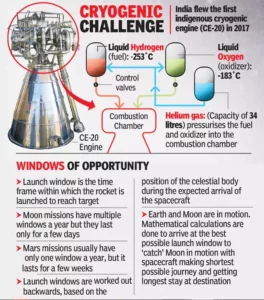CE20 Cryogenic Engine
#GS-03 Science and Technology
For Prelims:
About CE20 Cryogenic Engine:
- The CE-20 is a cryogenic rocket engine developed by the Liquid Propulsion Systems Centre, a subsidiary of Indian Space Research Organisation.
- The combustion chamber burns liquid hydrogen and liquid oxygen at 6 MPa with 5.05 engine mixture ratio.
- This has been indigenously developed for Launch Vehicle Mark-3 (LVM3), previously called the GSLV-Mk3.
- It is the first Indian cryogenic engine to feature a gas-generator cycle and is the most powerful upper stage cryogenic engine in the world.
- It was subjected to a successful hot test at an uprated thrust level of 21.8 tonne for the first time on 09-11-22.
- This will enhance the LVM3 payload capability up to 450 kg with additional propellant loading.
- During the test, engine and facility performance was normal and required parameters were achieved, according to ISRO.
About Launch Vehicle Mark-3 (LVM3):
- It is a three-stage launch vehicle consisting of two solid propellant S200 strap-ons on its sides and core stage comprising L110 liquid stage and C25 cryogenic stage.
- The S200 was developed at Vikram Sarabhai Space Centre.
- Primarily designed to launch communication satellites into geostationary orbit, it is also due to launch crewed missions under the Indian Human Spaceflight Programme.
- ISRO successfully conducted the first orbital test launch of GSLV Mk III on 5 June 2017 from the Satish Dhawan Space Centre.
- LVM3 will be capable of placing the 4 tonne class satellites of the GSAT series into Geosynchronous Transfer Orbits.





